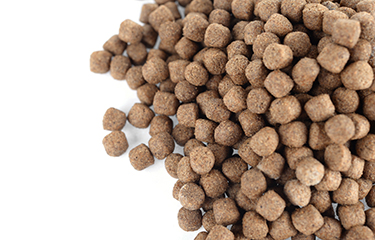A new report from Lux Research explores the future of alternative aquafeed ingredients, evaluating insect protein, single-cell protein, and algae protein as potential replacement options in fishmeal.
The FAO estimated in 2018 that aquaculture production would reach 201 million metric tons (MT) by 2030, in line with a 10 percent annual increase in demand for fish protein. However, according to IFFO, global annual fishmeal production from marine organisms – including fish, krill, shellfish, and algae – has remained at 5 million MT in recent years, with one third of the world’s fishmeal production coming courtesy of byproducts from wild-capture fisheries and aquaculture.
That number will have to significantly increase in order for the aquaculture sector to remedy future supply and demand gaps, Lux Research posited. The firm predicted in its latest report – which identified 20 producers of algae, 28 insect feed companies, and 16 producers of single-cell protein – that over the next 30 years, 15 million MT of new protein will be needed for aquaculture to meet the shortfall between supply and demand
In the past five years, the aquaculture feed ingredients sector has evolved, with insect protein, single-cell protein, and algae proteins emerging as major options to replace fishmeal, according to Lux. Of these alternative ingredients, Lux’s political, economic, social, and technological (PEST) analysis shows that insect protein and single-cell protein have the greatest likelihood of becoming major protein sources for aquafeed.
Lux predicted that single-cell proteins will become commercially relevant and scale more rapidly than insect proteins. Researchers noted the high production cost and low economies of scale of producing algae, which make it less well-positioned as a major protein source for aquafeed. However, algae may have more relevance as a replacement for fish oil, as it has high omega-3 fatty acid content, the Lux Research report suggested.
Increased production of algae-based ingredients is currently focused on biofuels, nutraceuticals, and human food, but algal oil production developments by companies, including Veramaris and AlgaPrime DHA, highlight opportunities within the aquaculture feed industry beyond replacing fishmeal.
“Few developers have reached large-scale production [of single-cell protein] due to the extremely high cap-ex required to establish a new facility. But there are currently many insect protein producers, operating facilities at a relatively small scale,” said Laura Krishfield, lead author of the report.
According to Lux, the largest insect production facilities – such as those of French company Ynsect and Malaysia’s Nutrition Technologies – currently produce around 10,000 MT a year, but indications are that their future production is set to double. If all currently operating insect producers achieve their plans for additional production facilities, global annual insect production could reach more than 350,000 MT by 2024. However, Lux’s analysis indicated that a global production level of around 200,000 MT of insects is more likely.
French biotech company InnovaFeed is one of the businesses producing black soldier fly (Hermetia illucens) larvae as an insect protein option for feed. In 2019, the company entered into a strategic partnership with Cargill to produce innovative feed products and to jointly market fish feed featuring insect protein. A year before that, the firm formed a strategic partnership with French retailer Auchan to launch the first ever insect-fed trout, which is now available in 52 supermarkets in France. There are plans to expand the reach throughout France by the end of 2020, the company said.
Additionally, InnovaFeed has been running a 1,000 MT pilot scale site since 2018, and the success of its commercial trials for trout and salmon has resulted in satisfied customers and increased orders. This positive reception has given the company confidence to commission its first full-scale, 10,000 MT insect protein plant, which is due to open in April 2020.
According to Lux’s Krishfield, single-cell protein production could reach more than 700,000 MT per year by 2024, but analysis indicates a more likely global production level of around 400,000 MT, as not all potential facilities will have secured the necessary investment by then.
“Combined insect and single-cell protein production levels should reach 600,000 MT annually by 2024,” she said.
Even though interest is growing in alternative proteins, if the sector is to reach critical mass, Krishfield said better governmental support is needed, particularly in terms of changes to feed legislation, improved production performance, and reduced costs.
The Lux report noted that in 2016, the U.S. Department of Energy (DOE) invested USD 15 million (EUR 13.7 million) to advance algae-based biofuels and bio-products, with the largest raise for algae proteins coming in at USD 4.7 million (EUR 4.3 million) in 2018 courtesy of Algaia, a France-based producer. In that same year, insect protein producers raised more than USD 170 million (EUR 157 million), and in the first half of 2019, they raised a further USD 157 million (EUR 145 million) in venture capital funds, the report found.
In the single-cell field, Menlo Park, California, U.S.A.-based Calysta has raised around USD 118 million (EUR 109 million) to develop its fermentation process, which uses natural gas to produce the firm’s FeedKind aquaculture feed comprised of 71 percent protein content. Calysta, which partnered with Cargill in 2016, is one of the few developers in this space to achieve commercial scale. The company also recently formed a joint venture with Adisseo.
The report predicted that genetic engineering (GE) technologies will significantly impact protein quality and efficiency of production moving forward. Although agriculture currently struggles with negative consumer attitudes toward GE, the report said developments in cellular agriculture and GE seafood will contribute to improved consumer impressions. The report also found that public sentiment would not be opposed to the use of alternative proteins in feed, if traceability and safety to consumers was communicated effectively.
Photo coutesy of SUPIDA KHEMAWAN/Shutterstock







